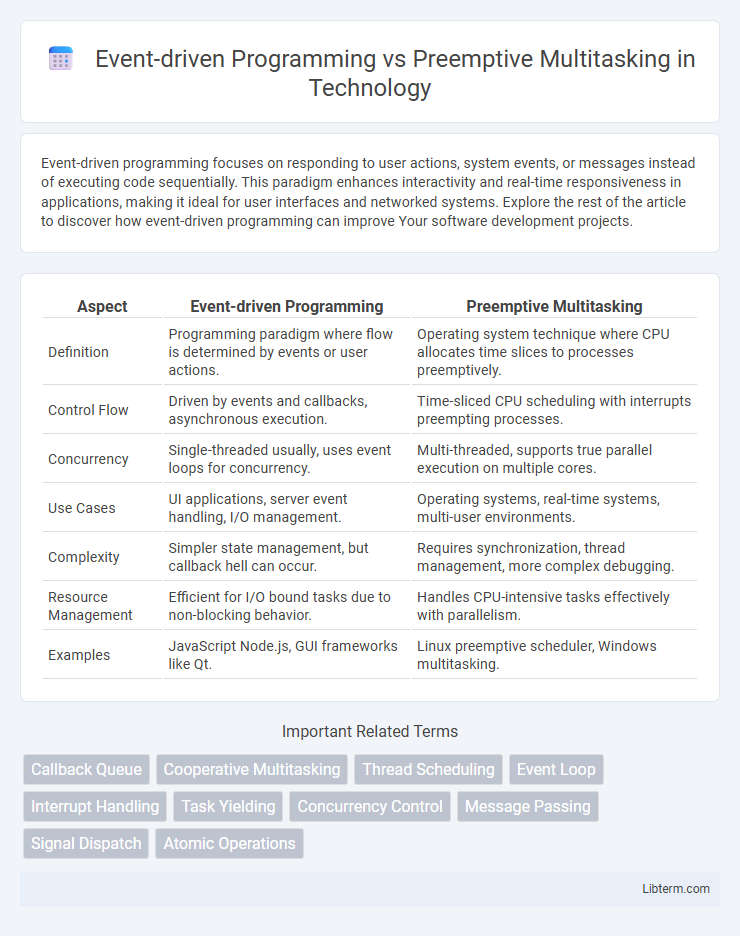Event-driven programming focuses on responding to user actions, system events, or messages instead of executing code sequentially. This paradigm enhances interactivity and real-time responsiveness in applications, making it ideal for user interfaces and networked systems. Explore the rest of the article to discover how event-driven programming can improve Your software development projects.
Table of Comparison
| Aspect | Event-driven Programming | Preemptive Multitasking |
|---|---|---|
| Definition | Programming paradigm where flow is determined by events or user actions. | Operating system technique where CPU allocates time slices to processes preemptively. |
| Control Flow | Driven by events and callbacks, asynchronous execution. | Time-sliced CPU scheduling with interrupts preempting processes. |
| Concurrency | Single-threaded usually, uses event loops for concurrency. | Multi-threaded, supports true parallel execution on multiple cores. |
| Use Cases | UI applications, server event handling, I/O management. | Operating systems, real-time systems, multi-user environments. |
| Complexity | Simpler state management, but callback hell can occur. | Requires synchronization, thread management, more complex debugging. |
| Resource Management | Efficient for I/O bound tasks due to non-blocking behavior. | Handles CPU-intensive tasks effectively with parallelism. |
| Examples | JavaScript Node.js, GUI frameworks like Qt. | Linux preemptive scheduler, Windows multitasking. |
Introduction to Event-driven Programming and Preemptive Multitasking
Event-driven programming uses events like user actions or messages to trigger specific functions, enabling efficient handling of asynchronous tasks without continuous polling. Preemptive multitasking allows an operating system to control CPU allocation by interrupting and switching between tasks, ensuring responsiveness and balanced resource use. Understanding these models is crucial for designing software that optimizes performance and responsiveness in diverse computing environments.
Core Concepts: Understanding Event-driven Programming
Event-driven programming centers on the concept of reacting to events or user actions through event handlers, allowing applications to remain idle until an event occurs, thus optimizing resource usage. This paradigm leverages an event loop that continuously listens for events such as mouse clicks, keyboard input, or messages from other programs, ensuring responsive and efficient application behavior. The core mechanism contrasts with preemptive multitasking by avoiding automatic context switches, instead relying on events to drive program flow and execution.
Core Concepts: Exploring Preemptive Multitasking
Preemptive multitasking allows the operating system to control CPU allocation by forcibly switching between tasks based on priority and time slices, ensuring efficient resource utilization and responsiveness. This core concept enables multiple processes to run seemingly simultaneously, improving system performance and user experience in multitasking environments. The scheduler's role is critical as it manages context switching, state saving, and task prioritization to maintain system stability and prevent deadlocks.
Architecture and Workflow Differences
Event-driven programming architecture relies on a centralized event loop that listens and dispatches events or messages, allowing tasks to run to completion without interruption. In contrast, preemptive multitasking utilizes a scheduler in the operating system kernel to allocate CPU time slices, forcibly interrupting tasks to ensure concurrent execution. Workflow in event-driven systems is non-blocking and callback-based, whereas preemptive multitasking involves context switching and thread prioritization to manage parallelism.
Performance Comparison: Responsiveness and Efficiency
Event-driven programming excels in responsiveness by handling events only when they occur, minimizing resource use and reducing latency for user interactions. Preemptive multitasking improves efficiency by allocating CPU time slices to multiple processes concurrently, though context switching overhead can impact performance. The choice depends on application requirements, with event-driven systems favoring lower latency in GUI and I/O-bound tasks, while preemptive multitasking suits CPU-intensive workloads needing parallel execution.
Scalability in Event-driven and Preemptive Systems
Event-driven programming enhances scalability by efficiently managing numerous concurrent events with minimal overhead, as it processes tasks asynchronously through event loops without creating multiple threads. Preemptive multitasking supports scalability by enabling multiple threads to run simultaneously on multi-core processors, but it incurs higher context-switching costs that can limit performance under heavy loads. Event-driven systems excel in scenarios with high I/O-bound operations, while preemptive multitasking is better suited for CPU-bound tasks requiring parallel execution on multicore architectures.
Application Domains and Use Cases
Event-driven programming excels in user interface design, real-time systems, and single-threaded applications where responsiveness to asynchronous events like user input or network signals is critical. Preemptive multitasking is foundational in operating systems, servers, and complex multitasking environments requiring concurrent process execution and efficient CPU sharing. IoT devices, embedded systems, and GUI applications frequently utilize event-driven models, while high-performance computing, database servers, and real-time operating systems rely on preemptive multitasking to manage multiple tasks with strict timing constraints.
Debugging and Error Handling Challenges
Event-driven programming complicates debugging due to asynchronous event callbacks and unpredictable event order, making it difficult to trace error origins and reproduce bugs consistently. Preemptive multitasking introduces challenges with race conditions and deadlocks, requiring rigorous synchronization mechanisms to prevent state corruption during concurrent thread execution. Effective error handling in event-driven models demands comprehensive event logging, while preemptive multitasking benefits from thread-safe debugging tools and breakpoint management to isolate faults in parallel processes.
Choosing the Right Model for Your Project
Event-driven programming excels in handling I/O-bound applications or user interfaces by responding to specific events with minimal resource consumption, making it ideal for interactive or real-time systems. Preemptive multitasking offers superior performance for CPU-bound tasks by allowing the operating system to allocate processor time efficiently among multiple processes, enhancing responsiveness and stability in complex or time-sensitive projects. Selecting the appropriate model depends on prioritizing factors such as task complexity, resource constraints, and the need for concurrency management in your project's architecture.
Future Trends in Event-driven and Preemptive Multitasking
Future trends in event-driven programming emphasize increased adoption of asynchronous frameworks and enhanced support for real-time data processing, driven by advancements in IoT and edge computing. Preemptive multitasking will evolve through more sophisticated scheduler algorithms and integration with AI to optimize resource allocation and reduce latency in multi-core processors. Both paradigms are converging towards hybrid models that leverage event-driven responsiveness with preemptive task management for scalable, low-latency applications.
Event-driven Programming Infographic

 libterm.com
libterm.com